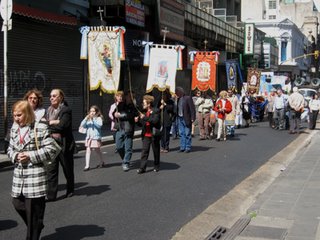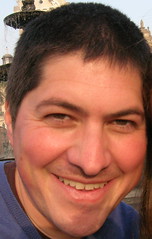10.05.2006
Religious processions
Professional tourguide, foodie, wine-lover, architecture freak and blogger Robert Wright keeps a terrific blog, Line of Sight, which details his life in Buenos Aires. He recently posted the photo below and commented:
Robert's photo got me to thinking that I am yet to see one of Lima's famous religious processions. As my I've been told, these are often monumental, day-long events, involving tens of thousands of people in a relatively small area, often funnelling down narrow, colonial streets. Needless to say, such a manifestation chokes the downtown streets for hours. Not that anyone's trying to get anywhere. On major religious holidays, the country essentially shuts down. If you're not in the procession, at church or home with family, you're undoubtedly a tourist.
What's our equivalent? Probably not Macy's parade, because the scale and pageantry of that event is determined by corporate largesse. Mardi Gras in New Orleans might be a closer (albeit irreverent) match. There, the procession is fueled not so much by marketing dollars but by the creative participation of krewes and individuals.
I've seen a few processions in Cusco and the environs. There, it seems that the border is blurred between Catholicism and the ancient but tenacious Andean religious beliefs. In the same event, it's not surprising to see a saint or virgen on a silver-crusted "anda", or platform, as well as individuals dressed in native masks and costumes.
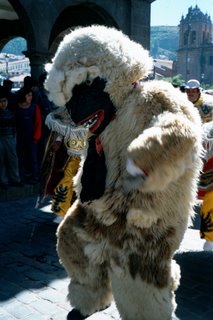
Corpus Cristi procession, Cusco 1999. Photo by Don Ball.
I'm not Catholic, but I have to say that even a small procession can be a mind-blowing experience. Once, in Urubamba, we were returning to our hotel from a restaurant and had to walk through a part of town that inexplicably had no power. On a pitch-black street, we met up with a religious procession -- some 100 people singing hymns a capella, each singer holding one small candle. We ducked into a doorway and watched and listened as the procession shuffled past us. It gave me goose bumps then and still does to this day when I think of it.
Anyway, as a point of contrast to Robert's photo from Buenos Aires, below is a capture of one of Lima's lesser events in the religious calendar: Virgen de la Puerta. From what I gather (happy to be corrected), it's not an unimportant celebration, but it's also not on the level of, say, Señor de los Milagros.
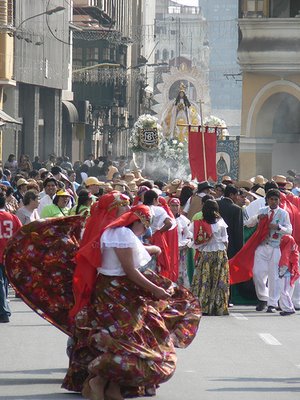
Virgen de la Puerta procession, Lima 2005. Photo by manarh.
Finally, I found an interesting painting that depicts a holy-week procession in Lima during the early 1800s. It's interesting to see that the artist has depicted people of different races and classes in the same scene. Note that the porters carrying the platform appear to be black and poor (when was slavery abolished in Peru?) while a few paces away we see something rare for the time: two wealthy black men.
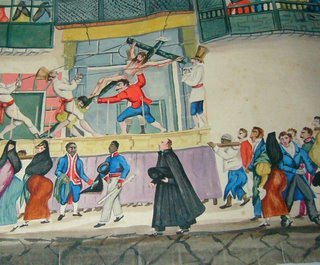
"Holy Week Procession in Lima", watercolor by Francisco Fierro, ca. 1832. Courtesy of the Hispanic Society of America.
Tags: Robert Wright, Buenos Aires, Line of Sight, Religious processions, Nuestra Senora de la Piedad, Lima, Peru, Cusco, Urubamba, Corpus Cristi, Senor de los Milagros, Virgen de la Puerta, Holy Week, Francisco Fierro.
"It’s rare to find a religous procession in Buenos Aires. In spite of Argentina being a mainly Catholic country, processions are nowhere as frequent as in Spain. Nor as fancy. While wandering around Congreso & photographing old street signs for a new walking tour logo design, I ran into a procession. Less than 100 people were taking Nuestra Señora de la Piedad around her yearly route downtown. Hardly impressive but unique for BA."
Religious procession in Buenos Aires. Photo by Robert Wright.
Robert's photo got me to thinking that I am yet to see one of Lima's famous religious processions. As my I've been told, these are often monumental, day-long events, involving tens of thousands of people in a relatively small area, often funnelling down narrow, colonial streets. Needless to say, such a manifestation chokes the downtown streets for hours. Not that anyone's trying to get anywhere. On major religious holidays, the country essentially shuts down. If you're not in the procession, at church or home with family, you're undoubtedly a tourist.
What's our equivalent? Probably not Macy's parade, because the scale and pageantry of that event is determined by corporate largesse. Mardi Gras in New Orleans might be a closer (albeit irreverent) match. There, the procession is fueled not so much by marketing dollars but by the creative participation of krewes and individuals.
I've seen a few processions in Cusco and the environs. There, it seems that the border is blurred between Catholicism and the ancient but tenacious Andean religious beliefs. In the same event, it's not surprising to see a saint or virgen on a silver-crusted "anda", or platform, as well as individuals dressed in native masks and costumes.

Corpus Cristi procession, Cusco 1999. Photo by Don Ball.
I'm not Catholic, but I have to say that even a small procession can be a mind-blowing experience. Once, in Urubamba, we were returning to our hotel from a restaurant and had to walk through a part of town that inexplicably had no power. On a pitch-black street, we met up with a religious procession -- some 100 people singing hymns a capella, each singer holding one small candle. We ducked into a doorway and watched and listened as the procession shuffled past us. It gave me goose bumps then and still does to this day when I think of it.
Anyway, as a point of contrast to Robert's photo from Buenos Aires, below is a capture of one of Lima's lesser events in the religious calendar: Virgen de la Puerta. From what I gather (happy to be corrected), it's not an unimportant celebration, but it's also not on the level of, say, Señor de los Milagros.

Virgen de la Puerta procession, Lima 2005. Photo by manarh.
Finally, I found an interesting painting that depicts a holy-week procession in Lima during the early 1800s. It's interesting to see that the artist has depicted people of different races and classes in the same scene. Note that the porters carrying the platform appear to be black and poor (when was slavery abolished in Peru?) while a few paces away we see something rare for the time: two wealthy black men.

"Holy Week Procession in Lima", watercolor by Francisco Fierro, ca. 1832. Courtesy of the Hispanic Society of America.
Tags: Robert Wright, Buenos Aires, Line of Sight, Religious processions, Nuestra Senora de la Piedad, Lima, Peru, Cusco, Urubamba, Corpus Cristi, Senor de los Milagros, Virgen de la Puerta, Holy Week, Francisco Fierro.

